Tower Language
Foreign Language Lessons, In-Company Classes, Translation
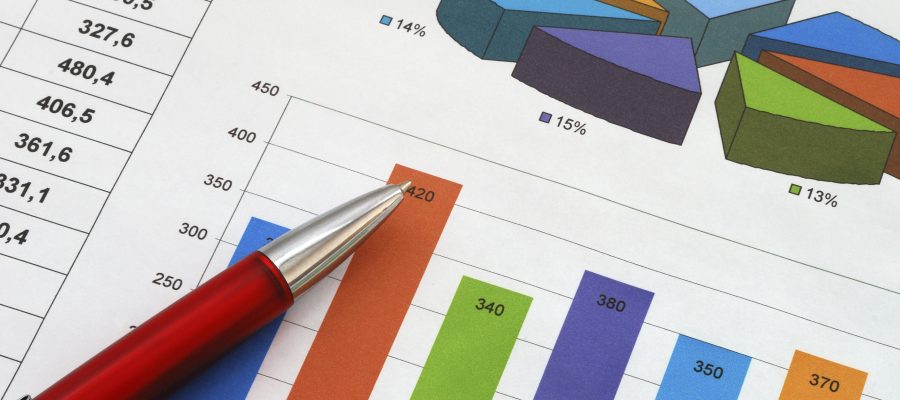

Useful Vocabulary for Writing Reports
Writing a report can be a long, daunting process. Fortunately, if you take it one step at a time and plan as you go, writing a report can an enjoyable learning experience.
Simply complete the following phrases and see for yourself.
INTRODUCTION
- The aim / intention / purpose of this report is to outline / present / discuss / sum up …
- Further to my visit to …, I have prepared the following report.
- I have recently visited … and have prepared the following report for your consideration.
- This involved visiting / looking at / investigating … / The data was obtained by …
- In order to help make this report I asked / discussed / gave out a questionnaire …
- It is based on my observations / the feedback from participants …
- My findings are outlined / presented below. / I outline my findings below.
- The report contains the relevant details concerning the problem as you required.
INTRODUCING POINTS
- To begin with … / Let us start with …
- First(ly) … / In the first place … / First of all … / The first aspect / thing to consider is …
- Second(ly) … / Third(ly) …
- Moreover … / Furthermore … / What is more …
- Another aspect to consider … / Yet another aspect / consideration is …
- Besides that … / Apart from that … / In addition to this … / On top of that …
In-Company Lessons with Native British Teachers
INTRODUCING YOUR OPINION
- I think / believe that … / In my opinion … / I am of the opinion that … / It seems to me that …
- Personally I believe that … / In my view … / If you ask me … / To my mind … / As far as I am concerned …
- I would like to suggest / recommend … / I therefore suggest / recommend …
- I (strongly) recommend … / My recommendation is to …
INTRODUCING SOMEONE ELSE’S OPINION
- A few / Many / The majority / minority of people said / reported / complained …
- According to … / As … said … / In the words of …
- It is said that … / It is often suggested that …
GIVING EXAMPLES
- For example / instance …
- This can be shown / illustrated / demonstrated / clarified by …
- Let me just give you an example, …
- The picture / diagram shows / illustrates …
- One of the main / biggest / most significant / … differences between … and … is …
- Unlike …, … is … / While / Whereas / Although … is, … is …
- … is completely / entirely / totally different from …
- … is a little / slightly / somewhat / a great deal bigger / more elegant / … than …
- … is not quite / nearly as comfortable / expensive / convenient / … as …
- … is virtually / exactly the same as … when it comes to …
Skype English Lessons with Native British Teachers
- It can be seen from the data / reactions / information above that …
- All things considered, I believe that … / Taking everyone’s comments into consideration …
- In general / On the whole I found that …
- In conclusion … / To conclude … / To sum up … / In summary …
- To put the matter in a nutshell … / In a nutshell …
Vocabulary to use when writing business reports in English exercise
Writing a good report is not only about knowing how you structure it and what type of things to include (and not include), but also how you say what you do include: the words and phrases you use.
Although your choice of vocabulary is not as important for writing good reports as what you actually write about, to look professional you should you try the right type of vocabulary and not overuse the same words and phrases in your reports.
To help you know what words and phrases to use in your own reports, I have created the below online exercise. Through reading an example of a good report and doing a quiz/test, you'll learn and remember some English vocabulary which will make your reports look more professional and read better.
If you have already done the exercise on ' how to write business reports ' (which explains what type of things to write about and how to structure them in a report), you don't need to reread the report below again. Just focus on the words and phrases in bold in the report and from the context which you find them in (e.g. the sentence they are in), think about what their purpose is and their meaning.
Example & Exercise: The report
The following report evaulates the performance of a help desk in a small bank. From the context, try to guess what the meaning and purpose of the words/phrases in bold are. Then do the quiz at the end to check if you are right.
Report on the customer help desk's inbound customer call performance
Introduction.
The following report evaluates the current performance level of our customer help desk based in Pudsey, Leeds. It focuses on its performance when dealing with inbound/incoming customer enquiries made by phone.
This report was produced in response to the results of a recent customer survey. This survey identified a high level of customer dissatisfaction with our company's help desk. Of the 1506 customers who left a rating for the help desk in the survey, 1254 of those rated the service as bad or terrible. Of this 1254, 67% gave the reason for their dissatisfaction as 'call waiting time', while 25% said that the 'service is unhelpful'.
The purpose of this report is to identify failings with the current set up of the help desk which could account for this low customer rating. And to recommend changes to the help desk to improve the service provided to customers.
The findings which are contained in this report are predominantly based on a combination of statistics from the help desk's call management system (CallCom) and random monitoring of calls (100 in total) between customers and help desk analysts. Both the statistics and the call monitoring stem from the same 7 day period (4 May to the 11 May 2015).
In order to ensure the integrity of the results, during the period of evaluation, nobody in the help desk section was aware that an evaluation was being conducted.
After this 7 day period, a number of interviews with staff at the help desk (the manager of the section, a team leader and 6 help desk analysts) were then conducted to hear their views and opinions.
In addition to the above, I also reviewed the processes and procedures in place at the help desk for dealing with inbound/incoming call customer enquiries.
Customer waiting time
From reviewing the statistics from CallCom, one thing did stand out , the customer waiting time (before a call is answered by an help desk analyst). The length of customer waiting time varied throughout the day. During most of the day, the average waiting time for customers was around 25 seconds, but during 5pm to 9pm (except on weekends), this rose to an average of 3 minutes and 44 seconds.
These 4 hours of the day, coincide with the highest call volume of the day for the help desk. On average, 41% of all calls each day were received during these 4 hours.
Chart showing the average customer weekday waiting time and the average percentage of calls received during the period of the study.
During these peak hours of call volume, the help desk does have more analysts answering customer calls. On average 10 extra staff (mainly part-time) are answering customer calls during these peak hours.
Length of call
Not only did customer waiting time increase during these peak hours, but there was also an increase in how long staff were actually speaking with customers during these hours as well. During 5pm to 9pm (except on weekends), the average time that analysts spoke to customers increased from 4 minutes 23 seconds to 7 minutes and 59 seconds.
Chart showing the average length of help desk analyst speaking time with customers during the period of the study.
During these peak hours of call volume, the nature of the calls did not differ significantly from those received during the rest of the day. But what did stand out was a difference between the length of time that full-time analysts spoke to customers during these peaks hours (on average 6 minutes and 56 seconds) and part-time analysts (on average 9 minutes and 28 seconds).
The statistics from ComCall indicated that although part-time analysts performed only slightly slower than their full-time counterparts on simple enquiries (e.g. confirming account and balance information), they performed significantly slower on more complex enquiries (e.g. freezing and resetting accounts).
Monitoring of customers calls supports this. On more complex enquiries, part-time staff put their customers on hold more often and for longer while they consulted with other staff to find out what they had to do.
Call procedures and processes
The procedures and processes that are in place in the help desk for dealing with customer enquiries meet the industry's highest standards (the standards set down in the Financial Services Association's customer service best practices).
Through monitoring calls between customers and help desk analysts, I can confirm that the vast majority of analysts always followed set procedures when dealing with customer enquiries. Furthermore , except for one or two occasions, they dealt with customers in a professional manner (even when customers were aggressive).
- The help desk's customer application system
From conducting interviews with help desk analysts, one of the things they stated was an issue was the slowness of the help desk's customer application system. In particular, they stated that the system had a tendency to run slow at peak hours (between 5pm to 9pm on weekdays). Resulting in them taking longer to deal with customer enquiries.
The monitoring of customer calls seems to confirm this. Analysts performed tasks using the system a lot slower when there were more staff taking calls (during peak call volume hours) than when there were less staff taking calls during the rest of the day.
The findings of this report on the help desk's performance would strongly seem to indicate that there is a problem with dealing with customer calls only during the hours of peak call volume (between 5pm to 9pm on weekdays). During these peak hours, the average waiting time for customers was nearly 10 times higher than during other times of the day (from an average of 25 seconds to an average of 3 minutes and 44 seconds).
Although it would appear that simply increasing the number of help desk staff taking calls would resolve this issue, the rise in the average time that analysts spoke to customers when dealing with enquiries (an average of 7 minutes and 59 seconds at peak call volumes in comparison with an average 4 minutes 23 seconds outside of these hours) would indicate that it is not only a problem of not having enough staff on at these times.
Although having more staff taking customer calls at these times should reduce the average customer waiting time, it would not address the issue of customer enquiries taking longer to resolve at these times. It would appear that this is the main factor causing the longer waiting times that customers are experiencing.
The findings would appear to demonstrate that this issue is caused by two main reasons:
- The underperformance of part-time staff
The first (and most important) reason is that there appears to be a problem with the help desk's customer application system. It appears to run a lot slower during periods of peak call volume when more analysts are logged on and using it.
The second reason is that part-time staff complete tasks slower on average than their full-time colleagues. This would appear to not stem from a lack of willingness on their part to answer calls quickly, but that they have less experience on resolving more complex customer enquiries.
Recommendations
On the basis of the above findings, I make the following recommendations:
1. Request the I.T. department to perform an investigation into the problems experienced with the help desk customer application system as soon as possible.
2. Undertake a training programme for part-time help desk staff to improve their knowledge and speed in dealing with customer enquiries (especially more complex enquiries).
If you require any clarification or further information on the report, please do not hesitate to contact myself (James Smith) by email ([email protected]) or by phone (01535 666541).
Below is a definition/description of each of the words/phrases in bold from the above text. Now choose the word/phrase from the question's selection box which you believe answers each question. Only use one word/phrase once. Click on the "Check Answers" button at the bottom of the quiz to check your answers.
1. A formal way to say 'said', is
2. A more formal way of saying 'strongly suggested that', is
3. A phrase which is used to begin the paragraph where you explain to the readers the reasons behind why you are writing the report, is
4. A more formal way to say 'wasn't caused by' is
5. A more formal way to say 'carrying out', which you can use to say how you got the data that you are using in the report, is
6. A phrase which you use to introduce the part of the report where you say from where and how you obtained the data that you are using in it, is
7. A verb which you use when you want to say that you noticed something important when you were investigating or evaluating, is
8. A phrase which is used to begin the paragraph where you tell the readers what the report looks at, is
9. A formal way to say that there 'wasn't a big difference' between two things, is
10. A different way of saying 'causing', is
11. A phrase you would use when you want to say that doing an action 'won't have any impact on resolving' a particular problem, is
12. A more formal way of saying 'clearly show that', is
13. A phrase which is used to begin the paragraph where you tell the readers what you want to achieve in the report, is
14. A different way to say 'in addition', is
Now that you understand the vocabulary, practise it by writing your writing your own report with these words/phrases.
©2024, Blair English
- Meeting Exercises
- CV & Interviews Exercises
- Numbers & Figures Exercises
- Emails Exercises
- Presentations Exercises
- Projects Exercises
- Verbs/Phrasal Verbs Exercises
- Social Exercises
- General Business Exercises
- Negotiations Exercises
- Food & Drink Exercises
- Technology & Web Exercises
- Financial English Exercises
- Articles Selection Page
- Travel & Hotel Exercises
This is me, Chris Clayton, the owner and main writer for Blair English. I'm also a part-time English teacher in sunny Spain. I have a love of history and the web. I hope you find the website useful.
Breakout English

How to write a report
Are you planning to take an English exam like Cambridge B2 First, C1 Advanced or the Trinity ISE exams and feeling overwhelmed by the prospect of writing a report? Let’s discuss the style and purpose of a report, the suggested format when you write a report for an exam, and useful phrases for reports. Finally, we’ve got some free downloadable materials to learn useful phrases for reports and sample writings to practise at home.

Style and purpose of a report
The style of a report should be formal and objective, presenting information in a clear, concise, and logical way. The purpose of a report is to communicate important information, findings, and recommendations to a specific audience in a structured and organised format. A report should also provide evidence to support its claims, such as statistics, data, and expert opinions.
Reports in English exams are mini-replicas of what you would be expected to write in a professional context. These may be written for a company, a government organisation, or for a university/school setting.
How to write a report with paragraph headings
A report typically follows a specific format with paragraph headings that make it easier for the reader to navigate the content. In the real world, a report would probably be several pages long, with multiple sections, and packed full of data, graphs and conclusion based on those. Obviously, in 150-250 words (depending on the exam) you can’t do that, but it’s good to keep paragraph headings to split up the text into sections. This leaves you with a four paragraph plan, much like we have for many other writings.
- Introduction : This sets the context and outlines the purpose of the report.
- Main body 1 : This contains the findings and analysis related to the topic.
- Main body 2 : This contains further analysis and recommendations.
- Conclusion : This summarises the key points made in the report and a call to action for the main recommendations.
Paragraph headings should be descriptive and focussed on the content of each section. Both Introduction and Conclusion can be the headings of your first and last paragraphs, while the central ones can often be taken directly from the question. What headings would you use for this sample question?

Remember to include a title in your report as well. It doesn’t have to be exciting or engaging like an article, but it should describe what the report is about.
Seeing samples is a good way to learn how to write a report. This example is the answer to the question above.
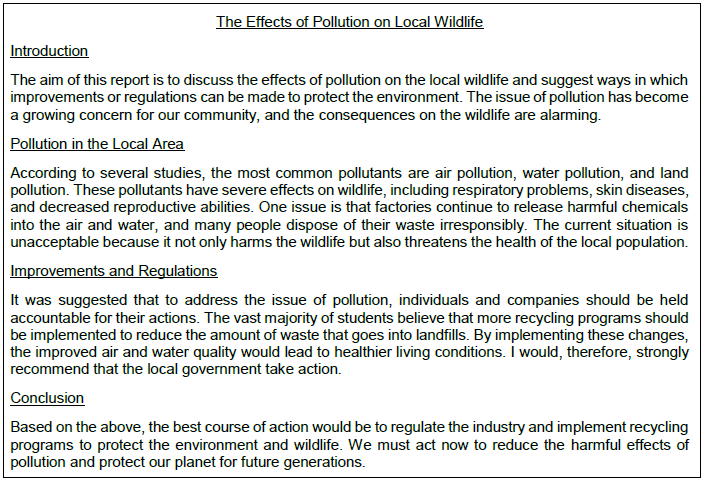
Useful phrases for reports
To write a successful report, it’s essential to use appropriate phrases that convey your ideas clearly. There are often many ways to do this, but you will want to learn several of them for exam day. The useful phrases we recommend considering include:
- The aim of this report is to…
- This report considers several aspects of [topic] in order to…
- The findings of this report/survey are outlined below.
- One issue is that…
- The current situation is unacceptable because…
- According to several students/employees/clients…
- It was suggested that…
- The vast majority of students/employees/clients believe…
- I would therefore strongly recommend…
- Based on the above, the best course of action would be…
These phrases are all part of our downloadable materials below, so if you want more practice, check them out. With practice and dedication, you can write a successful report that impresses your examiners and earns high marks.
The materials
These materials can be used in class or individually. First, you’ll discuss the purpose of reports and some details. Then there is a quick task to learn some useful phrases for reports. Finally, you can test if you know how to write a report by trying one or both of the practice questions. Both questions include sample answers.
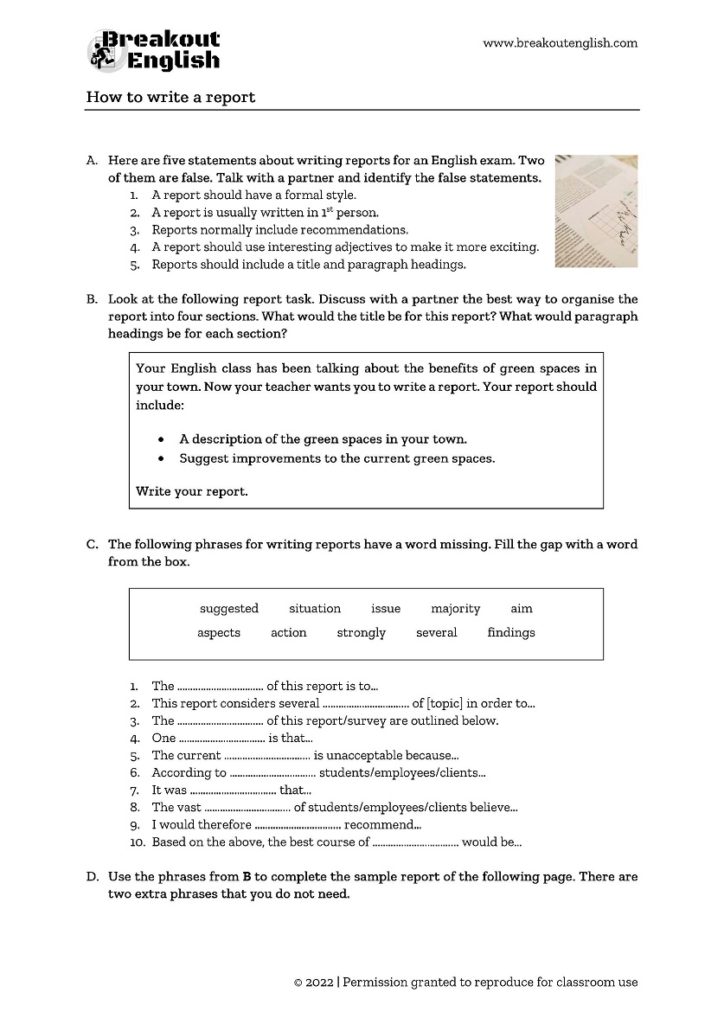
How to write a report (with tips and examples)
Delve into our practical guide designed to improve your report writing skills. Explore example reports and discover useful tips for writing clear and effective reports.

1. Understand Your Purpose: Always start with a clear understanding of your report's objective. This clarity guides your research, the writing process, and the way you present your findings.
2. Emphasize Clarity and Precision: Your report should be written in clear, simple language. Prioritize precision and avoid unnecessary jargon. Use visuals to represent complex data effectively.
3. Refine Through Revision: Never underestimate the power of editing and proofreading. These steps are critical in enhancing the quality of your report. Additionally, seeking feedback from colleagues or mentors can provide valuable insights.
What is a Report?
Imagine having to comprehend the intricate details of a six-month-long project in a single meeting, or having to make an informed decision based on a sea of raw data. Overwhelming, isn't it? This is where the power of a report comes into play.
A report is a strategic tool that communicates the results of an investigation, a project, or any complex analysis in a clear and concise way. It is the torchlight that cuts through the dense forest of data and information, guiding us toward understanding and action.
At its heart, a report is about simplicity and clarity. It takes the core findings from a more complex investigation and distills them into a simpler, easier-to-follow narrative.
Take, for example, a Financial Analysis Report in a business setting. Such a report takes a mountain of financial data – from revenue to expenses, assets to liabilities – and transforms it into a clear analysis that highlights the company's financial health, trends, and areas that need attention. By distilling complex financial data into a digestible format, the report empowers decision-makers to understand the company's financial state and make informed strategic decisions.
Types of Report
Reports come in all shapes and sizes, each designed to communicate specific types of information to particular audiences. Here are five common types of reports used in a professional setting:
Project Status Report
As its name suggests, a Project Status Report provides an update on a specific project's progress. It typically includes information about completed tasks, ongoing work, any challenges encountered, and next steps. This report is crucial in keeping stakeholders informed and facilitating timely decision-making. For example, a project manager in an IT company might prepare a weekly Project Status Report to update the leadership team about the progress of a new software development project.
Financial Report
A Financial Report is an essential document in the business world. It provides a comprehensive overview of a company's financial health, including details about revenue, expenses, profits, losses, assets, and liabilities. These reports, often prepared quarterly or annually, help stakeholders, investors, and decision-makers understand the company's financial performance and make better-informed strategic decisions.
Research Report
Research Reports are commonly used in both academia and various industries. These reports present the findings from a research study, detailing the research methods, data collected, analysis, and conclusions drawn. For instance, a market research report might reveal consumer behavior trends, helping a company shape its marketing strategy.
Audit Report
An Audit Report is a formal document outlining an auditor's unbiased examination of a company's financial statements. It gives stakeholders confidence in the company's financial integrity and compliance with regulatory standards.
Progress Report
A Progress Report is often used to monitor the advancement of ongoing work or projects. These reports can be on an individual, team, or organizational level. For example, a sales team might produce a monthly progress report showing sales volumes, trends, and areas for improvement.
Each type of report serves its unique purpose and shares a common goal: to transform complex information into an accessible format that drives understanding, decision-making, and progress.
How to Format a Report
Every report requires a structured format for clear communication. The actual format of a report might vary depending on its purpose and formality, but here are the key components of an effective report:
1. Title Page: The Title Page should include the report's title, your name, the date, and often the name of your organization or institution.
2. Executive Summary: A succinct overview of the report's key points, findings, and implications. This section gives the reader a clear idea of what to expect from the report. Sometimes it's easier to compose this section last, once the rest of the report has been completed.
3. Table of Contents: A systematic list of the report's sections and subsections, acting as a navigational tool for your reader.
4. Introduction: The foundational part of the report. It introduces the topic, outlines the report's purpose, and defines its scope, preparing the reader for what's to come.
5. Methodology: An explanation of the methods and tools used for gathering and analyzing data. This section establishes the credibility of your findings and helps the reader comprehend your investigative process. This is perhaps more common in an academic setting: a project status report, for example, is less likely to need a section dedicated to methodology.
6. Findings/Results: The section where you detail your data and the results of your analysis. This is the core of your report, presenting the results of your investigation or research. As well as written data, you should include graphs, images and tables to present your findings, where appropriate.
7. Conclusion: The summary and interpretation of your findings. It reaffirms the insights your report offers and solidifies the report's overall message.
8. Recommendations: Based on the findings, this section proposes future actions or improvements, steering the course for next steps.
The final two sections are perhaps more common in an academic report, but both are worth mentioning here too:
9. Appendices: A place for any supplementary information or data that supports your report but isn't part of the main flow. It serves as a resource for readers interested in delving deeper into the topic.
10. References/Bibliography: A list of all the sources you've cited in your report. This section gives due credit to the referenced works and showcases the depth of your research.
How to Write a Report
Writing a compelling report is a skill crucial to various professional roles, no matter what position or industry you’re in. While the subject of each report might differ, there are key steps to creating an impactful document:
1. Understand the Purpose
Before you start writing, make sure you fully understand the purpose of your report. Why is it needed? What questions should it answer? Who will be reading it? Understanding these factors will guide your research, writing style, and the overall structure of your report.

2. Conduct Thorough Research
A strong report is based on accurate and comprehensive data. In a business setting, this research is usually based on your own data, whereas in an academic setting you'll often rely on external data sources. Take the time to research your topic thoroughly, using reliable and relevant sources. Keep track of all the sources you consult—you’ll need them for your bibliography.
3. Plan Your Report
Start with an outline. This step ensures your report has a logical flow and covers all necessary points. Just like a blueprint, an outline helps you structure your thoughts, organize your data, and divide your content into meaningful sections.
4. Write Clearly and Concisely
Your goal is to communicate, not to confuse. Keep your language simple and your sentences short. Make your points clearly, and support them with facts. Avoid jargon unless it's necessary and you're certain your audience understands it.
5. Use Visuals When Helpful
Charts, graphs, tables, and other visual aids can enhance your report by illustrating complex data in a digestible way. Ensure all visuals are relevant, appropriately labelled, and referenced in the text.
6. Draft and Revise
Your first draft won't be perfect, and that's okay. The key is to start writing. Once you have your thoughts on paper, you can refine and reorganize the content. Revising is a critical part of the writing process —never underestimate its power.
7. Proofread
Review your report for grammar, punctuation, and spelling errors. Also, ensure all data and facts are accurate, and all sources are correctly cited (where applicable). An error-free report enhances your credibility and reflects your attention to detail.
8. Get Feedback
If possible, have a colleague or mentor review your report before finalizing it. They can provide fresh perspectives, point out any gaps, and suggest improvements.
9. Distribute the Report
Once your report is finalized, it's time to share your work. Distribute it to the appropriate audience, which may include your team, supervisor, or client. If the report will be discussed in a meeting or presentation , it might be helpful to distribute it in advance to give everyone a chance to review it.
Remember, writing a strong report is a blend of strategic thinking, thorough research, clear communication, and attention to detail.
Tips for Writing Successful Reports
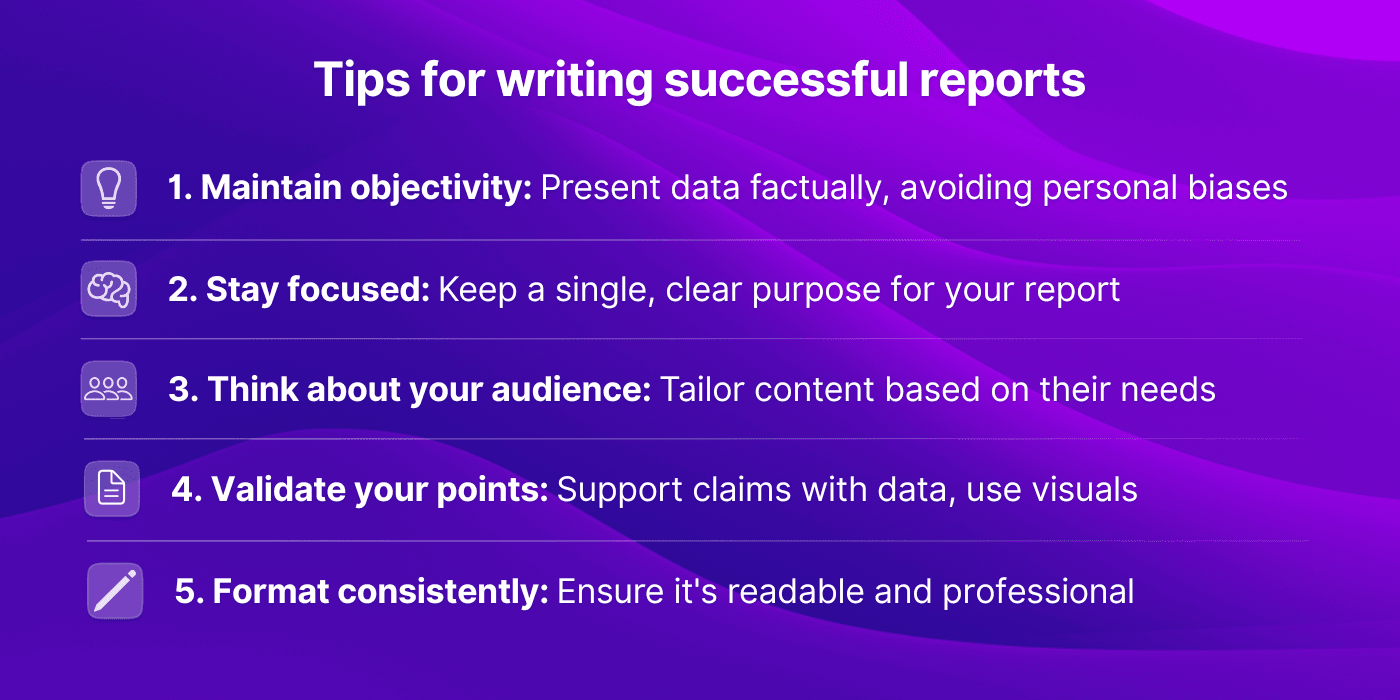
While the structure and purpose of reports may vary, certain principles apply universally to create successful documents. Here are five tips to elevate your report writing:
1. Maintain Objectivity
Your report should present data and facts as objectively as possible. Avoid letting personal biases influence the way you present information. Even when you're interpreting results or making recommendations, ensure that your conclusions are driven by the evidence at hand.
2. Stay Focused
Each report should have a single, clear purpose. Avoid going off on tangents or including irrelevant information. While it's important to provide context and background, don't lose sight of your report's main objective.
3. Think About Your Audience
Tailor your language, tone, and level of detail to the needs and understanding of your audience. A report written for experts in your field may use different language than one written for non-specialists. Always explain technical terms or industry jargon that your readers may not be familiar with.
4. Validate Your Points
Support every assertion you make with evidence or data. This adds credibility to your report and allows readers to understand the basis of your conclusions. Wherever possible, use graphics or visuals to illustrate your points—it’s a powerful way to represent data and ideas.
5. Format consistently
Consistency lends your report a professional look and helps readability. Stick to a consistent format in terms of font, spacing, heading styles, and captioning. Ensure your visuals are in sync with the rest of the document in terms of style and color scheme.
Reports are powerful communication tools, vital in various professional settings. The ability to write an effective report is a skill that can significantly enhance your impact in the workplace. From understanding what a report is, knowing the different types of reports, through to formatting and writing your report, the goal of this guide was to provide a comprehensive overview to help you excel in this critical skill.
By keeping the report’s purpose in mind, conducting thorough research, using a clear and concise writing style, and meticulously revising and proofreading your document, you can ensure your report not only communicates its intended information but does so in an engaging, digestible manner. Employing these strategies, combined with the tips offered, will help you create high-quality, impactful reports.
Make a report worth reading
Give Craft a try and discover how to bring your documents to life
More on reports

Transitional Words and Phrases
One of your primary goals as a writer is to present ideas in a clear and understandable way. To help readers move through your complex ideas, you want to be intentional about how you structure your paper as a whole as well as how you form the individual paragraphs that comprise it. In order to think through the challenges of presenting your ideas articulately, logically, and in ways that seem natural to your readers, check out some of these resources: Developing a Thesis Statement , Paragraphing , and Developing Strategic Transitions: Writing that Establishes Relationships and Connections Between Ideas.
While clear writing is mostly achieved through the deliberate sequencing of your ideas across your entire paper, you can guide readers through the connections you’re making by using transitional words in individual sentences. Transitional words and phrases can create powerful links between your ideas and can help your reader understand your paper’s logic.
In what follows, we’ve included a list of frequently used transitional words and phrases that can help you establish how your various ideas relate to each other. We’ve divided these words and phrases into categories based on the common kinds of relationships writers establish between ideas.
Two recommendations: Use these transitions strategically by making sure that the word or phrase you’re choosing matches the logic of the relationship you’re emphasizing or the connection you’re making. All of these words and phrases have different meanings, nuances, and connotations, so before using a particular transitional word in your paper, be sure you understand its meaning and usage completely, and be sure that it’s the right match for your paper’s logic. Use these transitional words and phrases sparingly because if you use too many of them, your readers might feel like you are overexplaining connections that are already clear.
Categories of Transition Words and Phrases
Causation Chronology Combinations Contrast Example
Importance Location Similarity Clarification Concession
Conclusion Intensification Purpose Summary
Transitions to help establish some of the most common kinds of relationships
Causation– Connecting instigator(s) to consequence(s).
accordingly as a result and so because
consequently for that reason hence on account of
since therefore thus
Chronology– Connecting what issues in regard to when they occur.
after afterwards always at length during earlier following immediately in the meantime
later never next now once simultaneously so far sometimes
soon subsequently then this time until now when whenever while
Combinations Lists– Connecting numerous events. Part/Whole– Connecting numerous elements that make up something bigger.
additionally again also and, or, not as a result besides even more
finally first, firstly further furthermore in addition in the first place in the second place
last, lastly moreover next second, secondly, etc. too
Contrast– Connecting two things by focusing on their differences.
after all although and yet at the same time but
despite however in contrast nevertheless nonetheless notwithstanding
on the contrary on the other hand otherwise though yet
Example– Connecting a general idea to a particular instance of this idea.
as an illustration e.g., (from a Latin abbreviation for “for example”)
for example for instance specifically that is
to demonstrate to illustrate
Importance– Connecting what is critical to what is more inconsequential.
chiefly critically
foundationally most importantly
of less importance primarily
Location– Connecting elements according to where they are placed in relationship to each other.
above adjacent to below beyond
centrally here nearby neighboring on
opposite to peripherally there wherever
Similarity– Connecting to things by suggesting that they are in some way alike.
by the same token in like manner
in similar fashion here in the same way
likewise wherever
Other kinds of transitional words and phrases Clarification
i.e., (from a Latin abbreviation for “that is”) in other words
that is that is to say to clarify to explain
to put it another way to rephrase it
granted it is true
naturally of course
finally lastly
in conclusion in the end
to conclude
Intensification
in fact indeed no
of course surely to repeat
undoubtedly without doubt yes
for this purpose in order that
so that to that end
to this end
in brief in sum
in summary in short
to sum up to summarize

Improving Your Writing Style
This is an accordion element with a series of buttons that open and close related content panels.
Clear, Concise Sentences
Use the active voice
Put the action in the verb
Tidy up wordy phrases
Reduce wordy verbs
Reduce prepositional phrases
Reduce expletive constructions
Avoid using vague nouns
Avoid unneccessarily inflated words
Avoid noun strings
Connecting Ideas Through Transitions
Using Transitional Words and Phrases

Lernen mit Tina

Useful phrases for your report
Writing a concise, reader-friendly, and informative report is challenging for many employees, students, and pupils. That’s why I compiled this article for you, to provide you with useful phrases for your report. Read on and become a pro-report writer.

What to write in your introduction?
The introduction section of your report lets the reader know about the content of your writing. So, it’s essential to use these first sentences to let the reader know
- what the purpose of your report is
- what the topic is
In most cases, reports aim to present or summarise information.
useful introduction phrases for your report
- The purpose of this report is to …. (e.g. summarise, show, examine, analyse, present, inform, etc.)
- The aim of this report is to …
- This report (examines, analyses, shows, summarises, presents, inform, etc.)
- This report/It is based on… (a survey, a study) …
- The source for this report is (a recent survey on , a study on…etc.)
- ….(Insert number) people were questioned/interviewed and the results are presented below.
- The key findings are presented/outlined below.
What to write in your main body?
The main body of your report contains the necessary information you need to pass on to your reader. For example, you summarise the most important findings of a study. Depending on what you are expected to cover in your report, you need to also analyse the findings and write about the impact they have on your company, product, school, etc.
Make sure you know what you are expected to write about in your report!
useful main body phrases for your report
- According to the data, …
- There is a slight/moderate/steady increase/decrease in…
- Around/Nearly/Almost/About/Approximately … percent of…
- The amount/number of … has remained steady/stable/constant/unchanged at…
- The figures for… have risen/fallen since …
- Compared to …., the figures for … are high/low.
- There are several factors which affect…
- Several people claim/suggest/state that….
- There are a number of reasons for…
- As might have been expected…
- Contrary to expectations,…
- It is important to add that…
- It should not be forgotten that…
- It should be mentioned/added that…
- It should be kept in mind that…
- Reasons for this development/trend could be….
What to write in your conclusion?
The conclusion is the place where you give suggestions, recommandations, and shortly summarise the most vital points made in the main body of your report.
useful summary phrases for your report
- In the light of these findings, …
- Taking into account the findings, …
- For this reason/ these reasons, it might be a good idea to…
- A possible solution would be…
- It is suggested/recommended/proposed that…
- I/We would (strongly) recommend that…
- It is essential/vital/important/necessary to…
- It would be advisable to….
- It would be beneficial to…
- It is clear/obvious that
- After a thorough data analysis, it is clear that…
- A further consideration could also be…
- In short/brief, it should be therefore concluded that…
- To summarise/sum up, it has been shown that…
- All in all, it can be summarised that…
- Finally, it should be mentioned that…
I am sure that this collection of phrases for reports will help you to write a great report.
If you want to know more about report writing, you can check out the following articles:
5 steps on how to write a report
How to write effective reports

Das könnte dich ebenfalls interessieren

Effective Phrases for Writing a Letter of Complaint
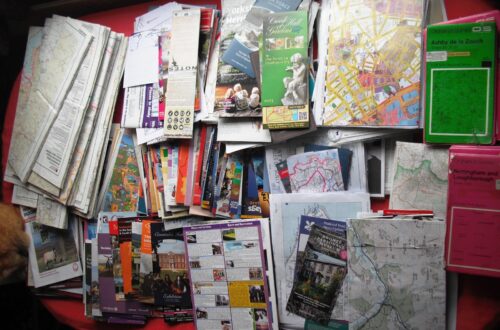
How to write a good leaflet

How to write an effective letter of complaint
Eine antwort schreiben.
Deine E-Mail-Adresse wird nicht veröffentlicht. Erforderliche Felder sind mit * markiert
Kommentieren

IMAGES
VIDEO
COMMENTS
− The purpose of this report is to… − I have written this report to… − This report has been written in order to… Explaining what you did in order to write the report − In order to prepare this report… − To do so, I… − The data in this report was obtained by… − In order to help make this decision,…
Writing a report can be a long, daunting process. Fortunately, if you take it one step at a time and plan as you go, writing a report can an enjoyable learning experience. Simply complete the following phrases and see for yourself. INTRODUCTION. The aim / intention / purpose of this report is to outline / present / discuss / sum up …
Compare with the phrases below Topic/ Purpose of report As the head of PR, I was asked to write a report on… The purpose of this proposal is to compare/ describe/ evaluate/ outline (the shortcomings of)/ summarise (the findings of a survey on)… This report aims to/ will investigate/ examine…
Resulting in: (phrase) In a report or any type of formal writing, you will probably use 'causing' quite a few times. The art of good writing is to not repeat the use of the same words or phrase too many times. So in addition to using 'causing', I would recommend that you also use 'resulting in' or 'leading to' as well.
Main body 1: This contains the findings and analysis related to the topic. Main body 2: This contains further analysis and recommendations. Conclusion: This summarises the key points made in the report and a call to action for the main recommendations. Paragraph headings should be descriptive and focussed on the content of each section.
In this lesson, I talk about the structure of a formal business report and share lots of great phrases for writing business reports.Formal business report st...
1. Understand Your Purpose: Always start with a clear understanding of your report's objective. This clarity guides your research, the writing process, and the way you present your findings. 2. Emphasize Clarity and Precision: Your report should be written in clear, simple language.
Phrases like “let’s circle back” or “I just wanted to touch base” feel like they’re referring to geometry or sports much than a business situational. 6 Tips to Write Irresistible Business Reports in English. But don, they’re part of the widely accepted corporate lingo.
Transitional words and phrases can create powerful links between ideas in your paper and can help your reader understand the logic of your paper. However, these words all have different meanings, nuances, and connotations. Before using a particular transitional word in your paper, be sure you understand its meaning and usage completely and be sure…
Depending on what you are expected to cover in your report, you need to also analyse the findings and write about the impact they have on your company, product, school, etc. Make sure you know what you are expected to write about in your report! useful main body phrases for your report. According to the data, …